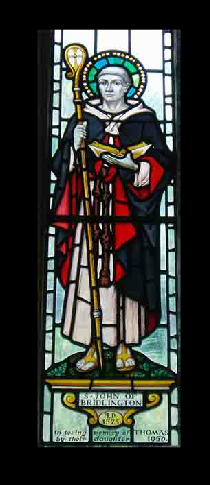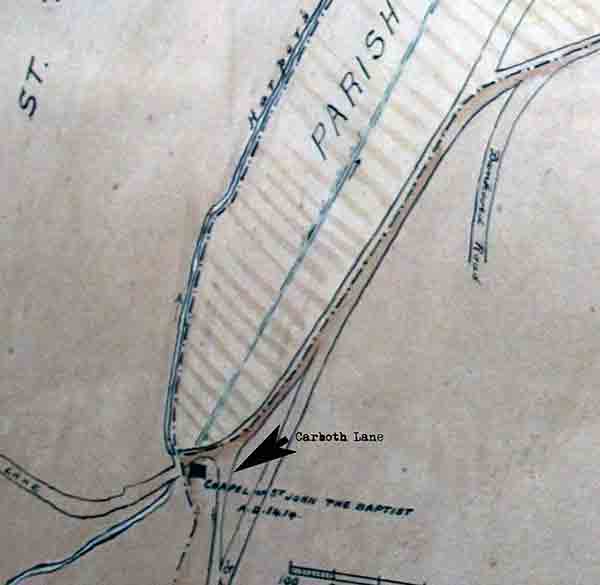.
Have you ever wondered why we have an area to the west of the town named as Chapple and St. Johns? After all, there is no chapel in the vicinity. Well Jim Edwards after some painstaking research, has transcribed from various sources has the answer;
On the 5th July 1410, John Honeyland was officially appointed Prior of the Augustinian Priory at St Thomas, Launceston, Cornwall. He, in 1427, erected within his Priory a chantry, at the altar of St Marguerite and St John of Bridlington, whence one of the community was every week to officiate daily and continually in the morning. For this service, he was to be allowed two marks from Linkinhorne Vicarage, twenty-three shillings and fourpence from the farm (ferm) of the chapel of the curate of Tamerton, and six shillings and eightpence from the farm of the chapel of Wrington (Werrington).
On the 12th May 1414, Henry V. by Letters Patent, recited and confirmed to the “vill of Launceston” the Charters of Henry III, Richard II, Henry IV, and Edward, Black Prince:
“To all faithful Christians to whom these present letters shall come, Henry Colyn, Mayor of the town of Launceston, and all the Commonalty of the same town, Greetings in the Lord. Know ye that we have given and granted to John Crese, the founder and guardian of a certain Chapel, devoted to the honour of St John the Baptist*, which he has determined to build at Trecarn Forde, in the territory of our Commonalty a place, foundation, and land sufficient for the aforesaid Chapel, where it may be more commodious, lawfully erected: To have and to hold to the said John and his successors, of us and our successors, in pure and perpetual alms forever. In Testimony whereof to one part of this writing, indented, remaining with the said John and his successors, the seal of the whole Town aforesaid is appended, and the other part remaining with the Mayor and Commonalty and their successors, is sealed with the seal of the said John. These being the Witnesses, Richard Respren, then steward of the aforesaid Town, john Wysa, Esq., Richard Trecoga, John Trelowney, William Langedon, and others.
Given at Launceston on Monday next after the feast of St Katherine the Virgin (November) in the 2nd year of the reign of Henry V., after the Conquest of England.”
From the Records of Lacey, Bishop of Exeter: “The Will of John German, rector of Lawhitton, dated 31 March 1428: Executors – John Crese, chaplain, and Henry German, his brother. Provision for the alms, for 100 masses in a week and other obits. Bequests to the stores of three fraternities at Lawhitton. vis., of All Souls, of St Mary and of St Katherine; to the fraternity of St John of Bridlington at Trecarnford, to Launceston priory, and personal bequests.
Testementum Johannis German: item- lego fraternitati sancti Johannis Bridlyngton de Tracarfford ij.s.”
Register of Edmund Lacey – Ordinations: “Ordinas (etc) in the Church Parish of Chudleigh 7 February 1432-3. Under sub-heading Presbitera:’ Johannes Honeland ad tit pr et con Launceston etc. ‘Stephanus Cornysh as tit pr et con Launceston de qus etc.’
On the 5th July 1410, John Honeyland was appointed Prior of Launceston Priory. He, in 1427, erected within his priory, a chantry, at the altar of St Marguerite and St John of Bridlington, wherein one of his community was every week to officiate daily and continuously in the morning”.
16th February 1427. Chudleigh. The Bishop sealed an ordinance for a chantry in Launceston Priory, founded at the instance of John the Prior, providing for a Mass to be celebrated daily forever at the altar of St Margaret and St John of Bridlington which the prior was to erect at his own expense, for the souls of the Bishop and the prior and their respective predecessors and successors, and of the brethren and benefactors of the convent. Beginning on the morrow of Michaelmas next the convent would appoint one canon every week to celebrate daily at dawn throughout the week at the said altar, for which he would receive 12d. from the chamberlain at the end of the week.
For an income from which to pay this reward, the Bishop assigned an annual pension of 2 marks from Linkinhorne vicarage, and the farm of Tamerton chapel, worth 23s. 4d. a year, and that of Werrington chapel, worth 6s. 8d. a year – with power to augment the total of these two farms up to 30s., should it ever fall short of that sum, from the tythes of the sheaves of the two chapels. The consent of the dean and chapter of Exeter was given in their chapter house on 21 February, 1427-8.
 St John of Bridlington: From the Penguin Dictionary of Saints: “John of Bridlington, canon regular. born at Thwing, died at Bridlington, 1379, f.d. 21 October. He studied at Oxford and joined the Austin canons at Bridlington near his birthplace, ultimately becoming their prior. He fulfilled his office with a notable combination of religious devotion, wisdom, and daily practicality, earning the love of his community. The miracles reported at his tomb doubtless facilitated his canonization.”
St John of Bridlington: From the Penguin Dictionary of Saints: “John of Bridlington, canon regular. born at Thwing, died at Bridlington, 1379, f.d. 21 October. He studied at Oxford and joined the Austin canons at Bridlington near his birthplace, ultimately becoming their prior. He fulfilled his office with a notable combination of religious devotion, wisdom, and daily practicality, earning the love of his community. The miracles reported at his tomb doubtless facilitated his canonization.”
From the Dictionary of National Biography: “ John of Bridlington (d.1379).
Austin canon. Born at Thwing, near Bridlington, he studied at Oxford University and became a canon at St Augustine’s monastery, Bridlington. Eventually, he was in turn precentor, cellarer, and lastly prior (1362). In an age when monastic slackness was fairly widespread, John gave an example of complete fidelity in small things as well as great. Some of his words have been preserved, among them a special recommendation to study the Fourth Gospel. As Superior he was prudent, wise, and greatly loved; he united a fervent life of prayer with the practical duties of his office with exceptional success. Miracles were reported at his tomb, after the usual inquiries he was canonized by Boniface IX in 1401.
Richard Scrope, archbishop of York, translated his relics on 11 March 1404.
The English success at the battle of Agincourt was attributed by Henry V to the intercession of the two Yorkshire Saints, John of Beverley and John of Bridlington. There is a 15th century stained glass window of him in Morley, Derbyshire. Feast 21 October.”
* This was to be the dedicated name but was changed to Bridlington before the erection took place.
The site of St. John’s Chapel is still known, but the fabric has disappeared. It stood near the fording-place over Harper’s Lake, about a furlong south-west of the Castle, by the side of the king’s highway which led from the Westgate of the town towards Landreyne, Pennygillam Cross (not the modern Pennygillam Crossways), Tresmarrow, and Bodmin. Trecarn Forde became Carford in 1460, Carforde in 1479-80, and Carborth in 1555. The place is now simply designated ” Chapple.”
John (d. 1379) called of Bridlington, saint, born at Twenge or Thwing, near Bridlington.
He was sent to school when five years old, and as a child was remarkable for his piety. In his 12th year, he took a vow of chastity, and when about twenty years of age became a canon regular at St Mary, Bridlington. According to Capgrave, he studied at Oxford. John took priest’s orders, and served various offices in his priory, being successfully master of the novices, precentor, almoner, and sub-prior. Finally, on 3rd January, 1361, he made prior. This seems to be the correct date, but Dugdale distinguishes him John de Twenge from John de Bridlington whose accession he dates on 13th ugly 1366. The two persons are no doubt identical, and Hugh expressly states that John at his death in 1379 had been prior for nineteen years, John was distinguished for his prudence and piety, and even in his lifetime is said to have performed many miracles: to have walked on the water, raised the dead, and filled his granaries by prayer. He died on 10 October, 1379, and was buried at Bridlington. Hugh gives his age as fifty-five, but the life in Capgrave as fifty-nine. It was soon reported that miracles were worked at his tomb, and in July 1386, on an application made by the prior of Bridlington, the vicar of the Archbishop of York gave orders for evidence to be taken as to their truth. In October 1400, John Gisburn, a canon of Bridlington, went to Rome to procure canonization of the late prior. He was actually canonized by a bull of Boniface IX, dated 24 September 1401. He was, however, honoured and worshipped as a saint within a few years of his death. His body was formally translated to his shrine by order of the Pope, and at the hands of the Archbishop and Bishops of the Northern Province on 11th May 1404.
His tomb was also resorted to by many pilgrims, among whom we find Thomas Beaufort, Duke of Exeter in 1417, and Henry V in 1421. Bale and later writers have identified St John of Bridlington with the author of the alleged prophetic verses relating to English history which were current under the name of a John of Bridlington. Mr Wright thinks the prophet a mere invention, and the true author-ship of the prophecy and the accompanying commentary unknown. In any case it is improbable that the prophecy, which, since it is dedicated to Humphrey de Bohun, seventh Earl of Hereford, must have been written between 1361 and 1372, should have been ascribed to a living and dignified ecclesiastic.
The prophecies were, however, well-known and accepted at Bridlington Priory within a few years of John’s death, and are largely used in the ‘Chronicles of Edward I. and II’.
The prophesies themselves are printed in Wright’s ‘Political Songs’. These prophecies are frequently referred to by Walsingham and other writers of his time, under the name of Bridlington, and were interpreted by them to foretell events of their own day, such as the death of Archbishop Scrope. Other works doubtfully ascribed to John are ‘Homilies’ and ‘Commenttanii super psaltenium cumcanticis, symbolo Anthanasii, et oratione Dominica’. The latter were once in the library of the monastery of Sion.
The first recorded religious community was situated at St Stephens (part of Launceston, on part of the site of the present church), soon after 900 AD. The brethren worked among the local population, teaching them cleanliness, farming, and general workmanship. The second Priory was first begun under the Exeter Bishopric, by ‘The fighting Bishop’
Warelwast, an appointee of William 1., in C.1125 AD. It was peopled by Augustians from the London Priory of Old Broad Street. This Priory was headed by Peter, ‘the Cornishman’, of a large land-owning family in Devon and Cornwall pre the Conquest.
It eventually had adjoining it five chapels, St John’s being the last to be erected. The Church of St Thomas (first dedicated to Thomas Beckett) was one of the chapels, the fabric is still in place and is the Church of the Parish of St Thomas the Apostle, Launceston, and is still the parish church in full use. It is believed the dedication was changed after Beckett was murdered by six knights, of whom one was a great local landowner, with great powers in Devon and Cornwall. Henry V made his pilgrimage just previous to leaving for France.
Bishop Lacey, of Exeter is also stated to have made a pilgrimage to St John’s grave.

The above collected by Jim Edwards, of Launceston, during a period of 1998 and 2009, with thanks to information from the York Cathedral library and many other sources.
Visits: 123
